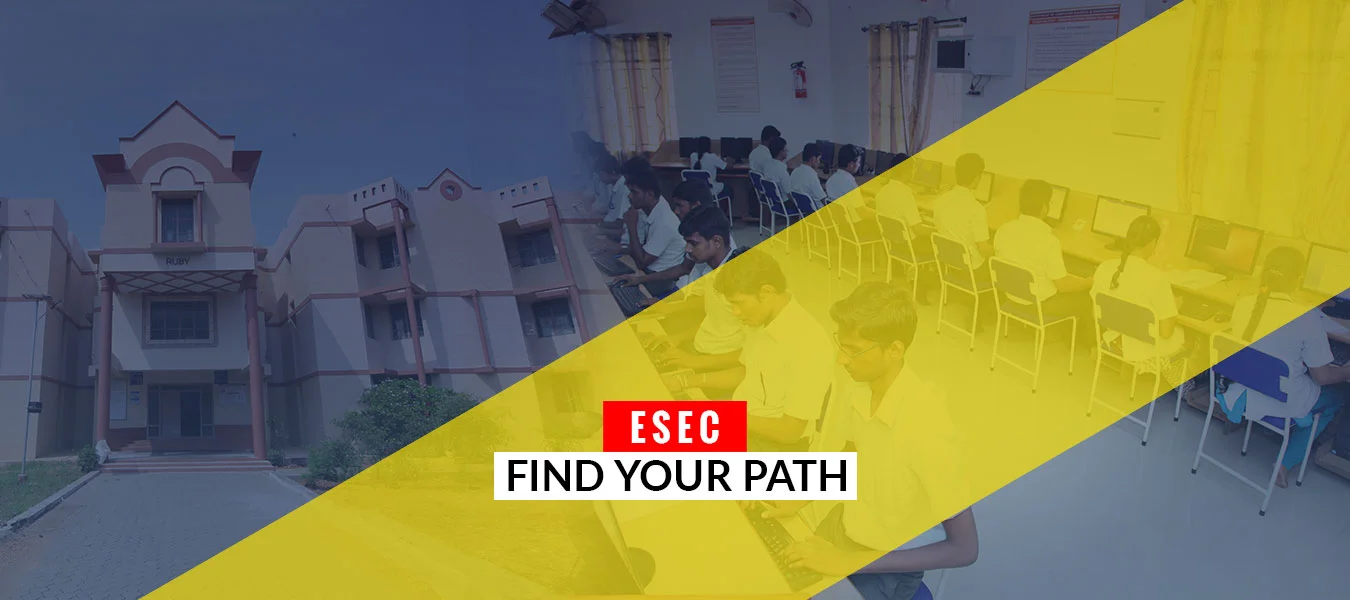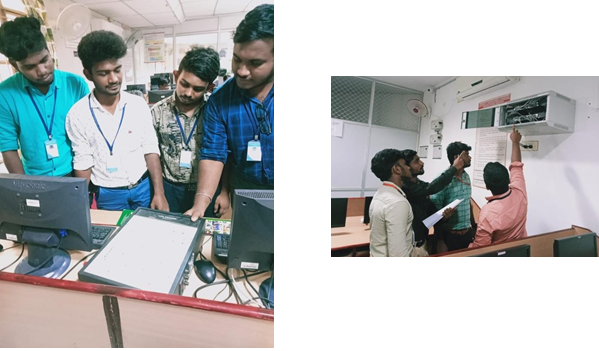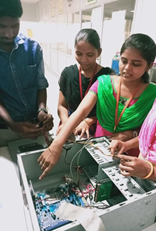

Department of Computer Science and Engineering
Innovative Teaching Methods

Role Play
In this session, one set of students were holding the board which contains the plain text and one student is holding the key value board. Another set of set of students are holding the boards which contains the encrypted text. Using the plain text and key, student who is holding the key will convert the plain text into cipher text. From the observation of CNS theory class, students have done an activity to convert plain text into cipher text using Caesar cipher technique.
Peer Learning
After completing the switching concept in classes, the students are divided into various groups. From the observation of switching concepts, students are allowed to discuss with their peer mates to have a clear idea on the switching concept as well as the different types of switching techniques.
In this session, after learning the basic types of networking concepts from the classroom, students are insisted to discuss about various types of networks using the LAN TRAINER Simulator and to compare the advantages and disadvantages among those types of networking concepts. From this, students can able to analyze the different types of networking concepts comparatively


Demonstration
In this session, computer scraps are used to demonstrate the Input/ Output organization in the CPU. After completing I/O organization in the classroom session, students are allowed to discuss with their peer mates to have a clear idea on the I/O Organization
Project Based Learning
Department of Computer Science and Engineering had conducted, “CODE SCAPE” (An internal code hackathon) for the students to motivate them to learn to provide solutions for the real time scenario. In addition to this real time problems were given as Mini Project for the students.


QUIZ – Using KAHOOT
In order to understand the concepts better, After completing the session, Multiple Choice Questions were Posted to the students. Thirty Seconds have been provided for each question. Maximum marks will be provided for the students those who are responding for the questions quickly. Finally, results will be displayed in the screen. By practicing this technique, students can able to retrieve something after learning it, and also it makes the students more likely to retain it for the long term.
YOUTUBE VIDEOS BY CSE FACULTIES
| S. No. | Name of the Faculty | Title of the Video Lectures | link |
|---|---|---|---|
| 1 | Dr.G. Saravanan | M-commerce | M-commerce |
| 2 | Dr.G. Saravanan | MPI overview | MPI overview |
| 3 | K.A. Damotharan | M-commerce | M-commerce |
| 4 | K.A. Damotharan | Tree Traversals | Tree Traversals |
| 5 | K.A. Damotharan | Functions | Functions |
| 6 | T. Kalaiselvi | Optimal Merge Pattern | Optimal Merge Pattern |
| 7 | S. Tamilselvan | Serializability | Serializability |
| 8 | S. Tamilselvan | Syntax Directed Translation | Syntax Directed Translation |
| 9 | R. Narendran | Distributed Mutual Exclusion and Non-Token based Approaches | Distributed Mutual Exclusion and Non-Token based Approaches |
| 10 | R. Narendran | Examples of DFD Model Development | Examples of DFD Model Development |
| 11 | Dr. S. Selvi | Triggers in database | Triggers in database |
| 12 | Dr. G. Revathy | Hill Climbing and Simulated annealing | Hill Climbing and Simulated annealing |
| 13 | Dr. G. Revathy | Functions | Functions |
| 14 | Ms. T.Kalaiselvi | Quick sort algorithm | Quick sort algorithm |
| 15 | Dr. G. Saravanan | Multi-Core Computer Architecture Storage and Interconnects | Multi-Core Computer Architecture Storage and Interconnects |
| 16 | Dr. G. Revathy | Constrains satisfaction problem | Constrains satisfaction problem |
| 17 | Dr. G. Revathy | Sorting | Sorting |
| 18 | Mr. S. Tamilselvan | Normalization | Normalization |
| 19 | Mr. R.Narendran | Global states and snapshot algorithms | Global states and snapshot algorithms |
| 20 | Dr. S. Selvi | Distributed Systems | Distributed Systems |
| 21 | Dr. S. Selvi | Global states and snapshot algorithms | Global states and snapshot algorithms |
| 22 | Ms.K.Senthilvadivu | Searching and Sorting | Searching and Sorting |
| 23 | Ms.K.Senthilvadivu | Searching and Sorting | Searching and Sorting |
| 24 | K.A. Damotharan | Mobile IP | Mobile IP |
| 25 | K.A. Damotharan | Graph Traversals | Graph Traversals |
| 26 | K.A. Damotharan | File handling in C | File handling in C |
| 27 | K.A. Damotharan | WML | WML |
| 28 | K.A. Damotharan | Shortest Path Algorithm | Shortest Path Algorithm |
| 29 | K.A. Damotharan | Interrupt Programming | Interrupt Programming |
| 30 | D. Sathya | Real Time | Real Time |
| 31 | R. Narendran | Consensus and Agreement | Consensus and Agreement |
| 32 | R. Narendran | Basic path Testing | Basic path Testing |
| 33 | K.A. Damotharan | m-commerce | m-commerce |
| 34 | K.A. Damotharan | Binary search tree | Binary search tree |
| 35 | K.A. Damotharan | Pointers | Pointers |
| 36 | M. Sivakumar | Storage Allocation | Storage Allocation |
| 37 | M. Sivakumar | Issues in Code Generation | Issues in Code Generation |
| 38 | R. Narendran | Two General Problem and Byzantine Fault Tolerance | Two General Problem and Byzantine Fault Tolerance |
| 39 | R. Narendran | Business Process Remodeling | Business Process Remodeling |
| 40 | K.A. Damotharan | Heap tree | Heap tree |
| 41 | K.A. Damotharan | Mobile Ad-hoc Network | Mobile Ad-hoc Network |
| 42 | K.A. Damotharan | Nested Structure | Nested Structure |
| 43 | Dr. S. Selvi | Triggers in DBMS | Triggers in DBMS |
| 44 | Dr. S. Selvi | Query processing and Optimization | Query processing and Optimization |
| 45 | R. Karunamoorthi | Quick Sort Algorithm | Quick Sort Algorithm |
| 46 | R. Karunamoorthi | Merge Sort Algorithm | Merge Sort Algorithm |
| 47 | Dr. G. Revathi | UML Diagrams | UML Diagrams |
| 48 | Dr. G. Sivakumar | Graphical User Interface in java | Graphical User Interface in java |
Contact Us
Erode Sengunthar Engineering College
Thudupathi, Perundurai, Erode - 638057
Contact No. : 9488568500, 04294 232701,702,703
Admission : Mail : [email protected], Mobile :9442132706, 9865279443, 9842465500, 9842865500
Official Mail Id : [email protected]
Principal Mail Id : [email protected]

